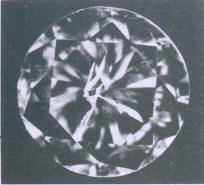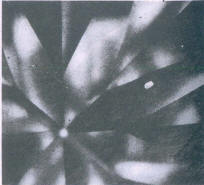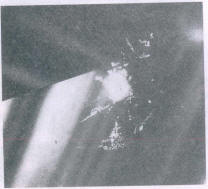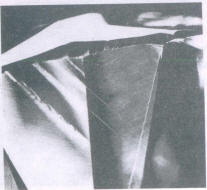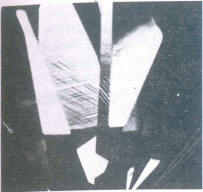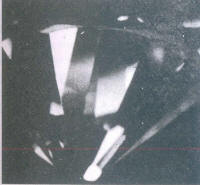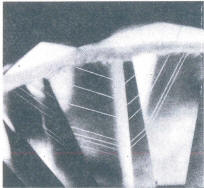- Description of inclusions (Cleavage, fracture and tension cracks, feathers, crystal inclusions, structural distortions, twinning lines and planes, growth lines and planes)
- Laser-drilled diamonds
- Filled diamonds

Description of inclusions
Inclusions are internal features which are wholly or partially surrounded
by the stone, for instance, crystalline and solid inclusions, dot-like inclusions,
clouds, cracks (cleavage-, fracture-, tension cracks) and structural phenomena.
Between the more common inclusions in diamond one can differentiate as follows:
- Cleavage cracks
-
These occur in the direction of the cleavage planes parallel to the four octahedral faces. They always occur in straight lines and the cleavage plane often shows a fine striation, similar to that of a cleaved piece of wood (Fig 15).
|
|
| Fig 15 Cleavage crack under the table (10 x} |
Also fringes and cracks along the girdle are counted as cleavage cracks; these were caused by careless bruting of the rough diamond (Fig 16 and 17).
|
|
|
| Fig 16 Cleavage cracks along the girdle (40 x) | Fig 17 Cleavage cracks In the in tenor of the stone (40 x) |
- Fracture cracks
-
These can occur in all directions and do not run along a cleavage plane. Their direction is irregular and often jagged. Fracture cracks are caused mainly by mechanical means, such as pressure or a blow (Fig 18 - 20).
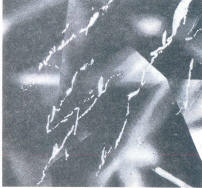 |
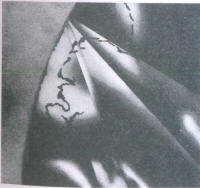 |
| Fig 18 Fracture cracks (40 x) | Fig 19 Fracture cracks (40 x) |

|
| Fig 20 Well-marked fracture crack (10 x) |
Fracture cracks can continue as cleavage cracks when they meet a cleavage plane. Both cleavage and fracture cracks can occur in the stone internally or can penetrate into the interior from the surface.
- Tension cracks
-
These are caused by differential thermal expansion of an included extraneous crystal and often surround the inclusion in a fan-like manner
|
|
|
| Fig21 Crystal Inclusion Snowing tension cracks (10 x) | Fig 22 Diamond octahedron showing tension cracks (20 x) |
- Feathers
-
-All types of cracks which are perpendicular to the crack plane and appear white and feathery are termed "feathers" or "glets". Also small blow marks and indentation marks on the edge of a facet are sometimes so described.
|
|
|
| Fig 23 "Feather" cleavage crack in pavilion facet edge (10 x) | Fig 24 As Fig 21 (30 x) |
|
|
| Fig 25 "Feather" In the shape of a cleavage crack |
- Crystal inclusions
-
These are included minerals which according to their nature can be colorless, reddish, brown, yellowish, greenish or black (Fig 26 and 27).
|
|
|
| Fig 26 A light crystal inclusion (30 x) | Fig 27 Inclusion showing garnet crystal with tension cracks (60 x) |
- Structure phenomena
-
These are clouds or obscurities consisting of microscopically small crystals of dust-like appearance. The type and nature of occurring clouds in diamonds are as numerous as clouds in the sky.
As long as these clouds are small and diffused, they diminish the clarity only slightly; however, if they are large and compact, they do influence the transparency and brilliance of a diamond and cause the stone therefore to be downgraded (Fig 28 and 29).
|
|
|
| Fig 28 Cloud In the shape of a cross (20 x) | Fig 29 Cloud (60 x) |
Twinning lines and twinning planes
A twinning plane is the growth plane between two twin crystals. In this plane the twin crystals meet in mirror-image crystallographic orientation of their hardness directions. It is therefore nearly impossible for the cutter to achieve a perfect polish and a homogeneous surface on the boundary of such a growth fusion. The stone surface shows a very fine "naat" which is the twinning line. This is generally a straight line, but the observer perceives it as curved when viewed through the opposite side of the stone. Thus twinning lines which occur in the pavilion but are seen through the crown appear definitely curved because of the cone shape of the pavilion (Fig 30).
|
|
| Fig 30 Twinning line ("Naat") (10 x) |
The twinning lines of twin crystals can in rare cases show a slight yellow or brown coloration which makes them appear as thin reflecting areas inside the stone. In such cases one does not speak of twinning lines, but twinning planes (Fig 31). In any case, they influence the clarity and depending on their discernibility, also the grade of clarity.
|
|
| Fig 31 Reflected twinning planes (20 x) |
Twinning lines are evaluated as external faults when grading the cut and lower the grade of cut depending on their influence on the brilliance of the stone.
Growth lines and growth planes
Growth lines and planes are inhomogenities which originated during the growth of the diamond by disturbances or irregularities, for instance, by alteration of temperature when they appear on the stone surface as fine, jagged lines; they can also form irregular shapes which cannot be cut or polished away because of their opposing crystal structure to that of the diamond (Fig 32). Growth planes are such irregularities which occur internally and which influence the clarity grade (Fig 33 and 34).
|
|
|
| Fig 32 Growth mark on pavilion facets (20 x) | Fig 33 Lattice type growth planes in the interior of the stone (30 x) |
|
|
| Fig 34 Quadratic growth planes in the interior of the stone (20 x) |
Grading: Cut or Clarity?
Because in practice of diamond grading the discernment of twinning and growth lines and planes and their grading into the cut or clarity scale is often difficult, the following photographs and their detailed explanation should help to clarify the position: both types of defects can appear as external faults (lines) as well as internal faults (planes) the former showing its influence on the cut, the latter on the clarity.
Twinning and growth lines are classified as external faults as long as they are colorless and appear as fine lines on the surface of the stone. Depending on number and size, their grade of discernibility and their influence on the brilliance, they can influence the grade of the cut.
The presence of a fine, short twinning or growth line, which can only be seen with difficulty with 10 x magnification, does not influence the grade of cut, the stone can still qualify for a "very good" cut (Fig 35).
|
|
| Fig 35 Growth line on pavilion facets (20 x) |
A longer twin naat which extends over several facets of crown or pavilion, as well as growth lines which are more easily discernable, classify the grade of cut as "good" (Fig 30).
If the brilliance is damaged by the presence of several parallel twin naats or larger growth features, the cut must classify as "medium" or "poor" (Fig 36-38).
|
|
|
| Fig 36 Several twinning lines in the crown as seen from pavilion (1Ox) | Fig 37 Several twinning lines in the crown (20 x) |
|
|
| Fig 38 As in Fig 37 but seen through the pavilion (20 x) |
Much rarer seem to be twin formations in the interior of the stone. One observes the twin planes mostly only in certain lines of view when moving the stone. Sometimes they seem more definite because of their yellowish or brown color. Twin planes are always classified as internal faults and influence like inclusions the grade of clarity (Fig 31).
Growth planes also occur as internal defects in the shape of zoned latticed striations, which are sometimes lightly brown in color (Fig 33 and 34). The grade of clarity in this case is also determined according to the grade of discernibility.
| Listing of Structural Defects in Accordance with IDC Rule | Laser-drilled diamonds |



